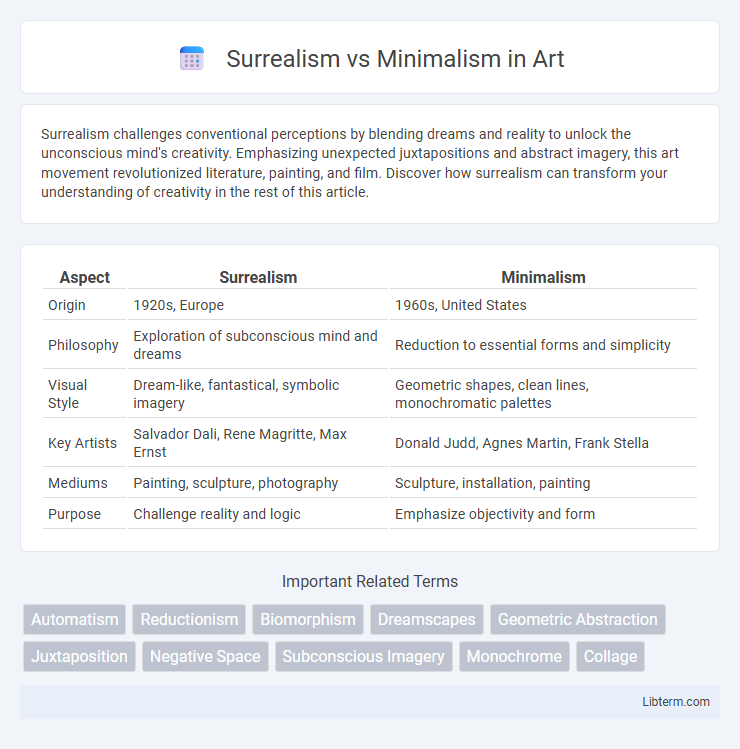Surrealism challenges conventional perceptions by blending dreams and reality to unlock the unconscious mind's creativity. Emphasizing unexpected juxtapositions and abstract imagery, this art movement revolutionized literature, painting, and film. Discover how surrealism can transform your understanding of creativity in the rest of this article.
Table of Comparison
| Aspect | Surrealism | Minimalism |
|---|---|---|
| Origin | 1920s, Europe | 1960s, United States |
| Philosophy | Exploration of subconscious mind and dreams | Reduction to essential forms and simplicity |
| Visual Style | Dream-like, fantastical, symbolic imagery | Geometric shapes, clean lines, monochromatic palettes |
| Key Artists | Salvador Dali, Rene Magritte, Max Ernst | Donald Judd, Agnes Martin, Frank Stella |
| Mediums | Painting, sculpture, photography | Sculpture, installation, painting |
| Purpose | Challenge reality and logic | Emphasize objectivity and form |
Understanding Surrealism: Origins and Key Concepts
Surrealism originated in the early 1920s as a revolutionary artistic and literary movement aimed at unlocking the unconscious mind through dream-like imagery and unexpected juxtapositions. Key concepts include automatism, free association, and the exploration of the irrational to challenge conventional perceptions of reality. Influential figures like Andre Breton and Salvador Dali shaped surrealism's emphasis on exploring subconscious desires and breaking logical constraints in art.
The Essence of Minimalism: Principles and Influences
Minimalism emphasizes simplicity, utilizing clean lines, monochromatic palettes, and essential forms to evoke clarity and focus within spaces or artworks. Rooted in post-World War II art movements, it draws influence from Bauhaus design, Zen philosophy, and American Abstract Expressionism, promoting reduction to fundamental elements. This principle seeks to remove excess, fostering an environment where functionality and aesthetic purity coexist seamlessly.
Visual Language: Surrealist vs Minimalist Art Styles
Surrealist art employs a visual language rich in dreamlike imagery, unexpected juxtapositions, and symbolic elements that challenge reality and evoke the subconscious mind. Minimalist art, in contrast, uses a visual language characterized by simplicity, clean lines, geometric shapes, and a restrained color palette to emphasize form and space over narrative content. While Surrealism thrives on complexity and emotional depth, Minimalism prioritizes clarity, order, and the essence of visual experience.
Philosophical Foundations: Contrasting Ideologies
Surrealism is rooted in Freud's theories of the unconscious mind, emphasizing dreams, irrational juxtapositions, and the exploration of the subconscious to unlock hidden desires and emotions. In contrast, Minimalism embraces existential and phenomenological philosophies that prioritize simplicity, essential forms, and the elimination of excess to reveal pure perception and objective reality. These opposing ideological frameworks reflect Surrealism's focus on complexity and inner chaos versus Minimalism's pursuit of clarity, order, and restraint.
Major Artists: Surrealism and Minimalism Icons
Salvador Dali and Rene Magritte, key figures of Surrealism, revolutionized art with dreamlike imagery and subconscious exploration, while Minimalism found its pioneers in artists like Donald Judd and Agnes Martin, who emphasized simplicity, geometric forms, and the removal of emotional expression. Dali's melting clocks in "The Persistence of Memory" epitomize Surrealism's fascination with distorted reality, contrasting sharply with Judd's industrially fabricated sculptures that highlight space and materiality characteristic of Minimalism. Rene Magritte's enigmatic scenes challenge perceptions, whereas Agnes Martin's subtle grids evoke tranquility, marking the distinct conceptual and visual philosophies defining both movements.
Surrealism in Modern Culture and Design
Surrealism in modern culture and design manifests through unexpected juxtapositions, dreamlike imagery, and symbolic elements that challenge conventional perceptions of reality. This artistic movement influences contemporary fashion, advertising, and digital media by creating visually provocative and emotionally engaging experiences. Surrealism's emphasis on the subconscious contrasts sharply with the clean lines and simplicity central to minimalism, highlighting distinct approaches to creativity in visual arts and design.
Minimalism's Impact on Contemporary Aesthetics
Minimalism's impact on contemporary aesthetics is evident through its emphasis on simplicity, clean lines, and functional forms, which have reshaped modern design across architecture, interior decor, and visual arts. By stripping away excess, Minimalism fosters a focus on essential elements, promoting clarity and tranquility in spaces and objects. This aesthetic philosophy champions the use of neutral palettes and open spaces, influencing digital design, product development, and lifestyle trends toward intentional and mindful consumption.
Emotional Expression: Surrealism’s Dreamscape vs Minimalism’s Restraint
Surrealism conveys intense emotional expression through dreamlike imagery and symbolic, often subconscious content that evokes mystery and deep psychological states. Minimalism emphasizes emotional restraint by using simplicity, clean lines, and limited color palettes to evoke calmness, clarity, and contemplative emotions. The contrasting approaches highlight Surrealism's exploration of complex inner worlds versus Minimalism's focus on purity and emotional subtlety.
Similarities and Divergences: Surrealism Meets Minimalism
Surrealism and Minimalism both challenge traditional artistic expression by emphasizing unique perspectives and emotional impact, yet Surrealism thrives on dreamlike, complex imagery while Minimalism embraces simplicity and reduces elements to their essence. Both movements reject excessive detail, but Surrealism relies on symbolic, often subconscious-driven content, whereas Minimalism focuses on clarity, geometric forms, and the elimination of personal narrative. The divergence lies in Surrealism's rich visual complexity versus Minimalism's austerity, yet their shared goal to provoke thought reshapes viewers' engagement with art.
Choosing Your Muse: When to Embrace Surrealism or Minimalism
Choosing between surrealism and minimalism depends on your creative goals and the emotional impact you wish to convey. Surrealism thrives on dreamlike imagery, unexpected juxtapositions, and subconscious exploration, ideal for artists seeking to evoke mystery and challenge reality. Minimalism emphasizes simplicity, clean lines, and reducing elements to their essence, perfect for those aiming to create clarity, focus, and visual harmony.
Surrealism Infographic

 libterm.com
libterm.com